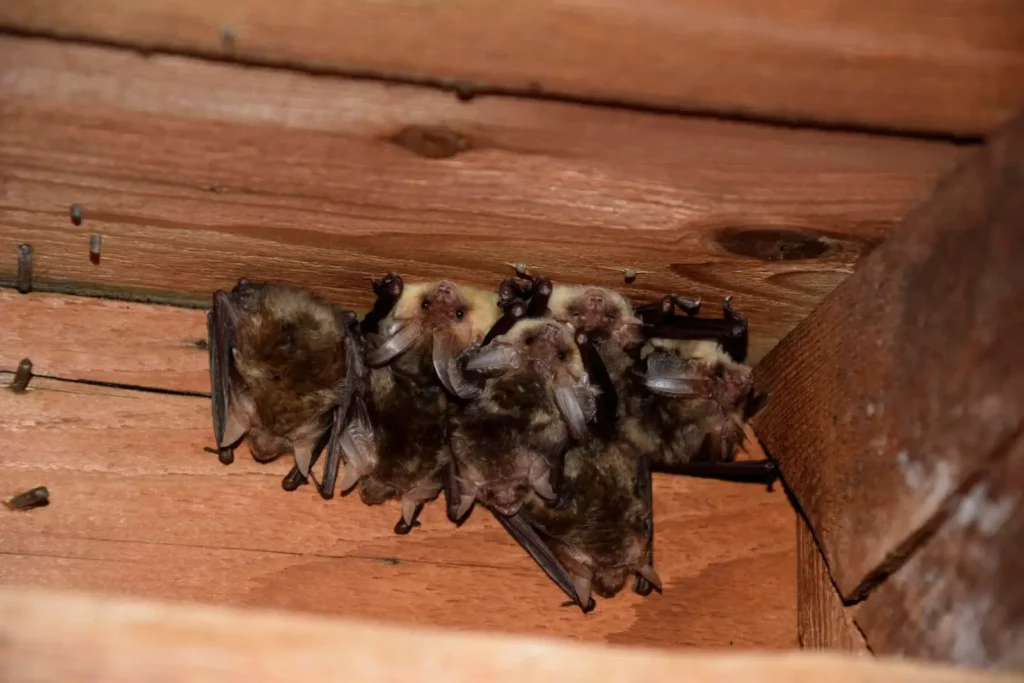Bats
What is a Bat?
A bat belongs to the order Chiroptera and is the only mammal capable of true flight. These animals play a crucial role in the ecosystem, including pollination and insect control. However, their presence in homes can pose health and safety issues.
How to Identify Bats?
Bats, with their distinctive silhouettes characterized by extended membranous wings and erratic flight, are easily noticed at dusk as they emerge in search of food. These fascinating and enigmatic flying mammals are often seen gliding silently through the twilight sky, navigating with remarkable precision thanks to their sophisticated echolocation system.
While they play a crucial role in the ecosystem by controlling insect populations, their intrusion into human living spaces, such as attics, behind shutters, or in lofts, can pose unique challenges. Their ability to infiltrate small spaces allows them to find ideal refuges in homes, where they can establish colonies, sometimes unbeknownst to the residents.

Additional Information on Bats
Pest Type
Mammal (Chiroptera), bats play a vital ecological role but can become pests when they infiltrate human habitats.
Appearance
Varies by species; they are generally small, with bodies covered in fur and membranous wings for flight.
Lifespan
Naturally, they prefer caves and hollow trees, but can adapt to attics or buildings to nest when they find favorable conditions.
Habitat
Naturally, they prefer caves and hollow trees, but can adapt to attics or buildings to nest when they find favorable conditions.
Diet
Most bats are insectivores, playing a crucial role in controlling insect populations.
Life Cycle
Reproduction varies by species, with generally one to two litters per year, each contributing to the survival of the species but increasing the risk of infestation in human habitats.
Do I Have a Bat Problem?
If you hear scratching or wing flapping noises in the walls or attic, or if you find droppings (bat poop also called guano) in your home, Exterminapro’s intervention may be necessary for safe management of these nocturnal visitors.
Signs of a Bats Infestation
- Ammonia Odor: The accumulation of bat urine can emit a strong ammonia smell, particularly in areas of intense activity or nests.
- Nocturnal Noises: Movements or flight of bats in the attic or behind walls are often the first signs noticed by residents.
- Presence of Droppings/Guano: The distinctive black and elongated droppings of bats, found near entry points or in attics, are a clear indicator of their presence.


Risks Associated with Bats
While invaluable to the environment for naturally controlling insect populations and participating in pollination, bats can unfortunately become unwelcome hosts when they decide to settle in human dwellings.
Their presence is not without risks; they can carry diseases transmissible to humans, such as rabies, a major public health concern. Moreover, the guano they leave behind, although an excellent fertilizer, can be a vector for respiratory diseases, such as histoplasmosis, if the fungal spores it contains are inhaled.
Faced with these health issues, Exterminapro offers bat control and management methods that respect both the health of residents and the well-being of these valuable mammals. By adopting respectful and ethical approaches, we ensure that the cohabitation between humans and nature remains harmonious and safe.
What are the Treatments for Eliminating Bats?
Preventing Bat Infestations
- Inspection and Sealing of Entry Points: A thorough evaluation of buildings to identify and seal all points through which bats could enter, using durable materials for long-term protection.
- Installation of Screens or One-Way Valves: These devices allow bats to leave a space but prevent their return, a crucial step in exclusion strategies.
- Regular Maintenance of Buildings: Maintaining structures in good condition is essential to prevent deterioration that could offer access to bats. This includes repairing roofs, gutters, and shutters.
Types of Treatments to Control Bats
- Exclusion Methods: These non-lethal techniques encourage bats to leave the premises naturally, without causing them harm. This involves creating temporary exits that allow bats to exit but not re-enter.
- Echolocation Devices: These devices emit sounds that disrupt bats’ echolocation, discouraging them from entering or staying in treated areas. This is a respectful method to keep them away from homes.
- Advice and Assistance for Securing Homes: Exterminapro provides tailored advice and technical assistance to make your home less inviting to bats, by identifying and modifying attractive conditions.
How to Permanently Eradicate Bats?
Exterminapro is committed to resolving your bat problems ethically and sustainably, using techniques that respect wildlife while protecting your home.
Intervention Process
How Much Does It Cost?
Get a Free Estimate
The rate for an Exterminapro intervention depends on the extent of the infestation and the solutions implemented. Contact us for a free estimate and regain peace of mind with our professional services.

